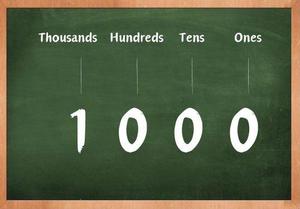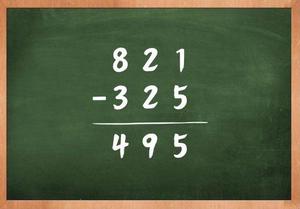Digits are the building block of mathematics, as all the numbers are made up of digits which can also be called numerals i.e., 0 to 9. Digits are the same as letters in the language. Digits have their meaning as individual entities and they combine to form numbers as well. These symbols i.e., numerals, represent values in mathematics and the real world. Digits have a place value and face value. Place value shows the digit’s worth based on its position in a number. Face value represents the digit’s actual worth. Digits are essential in everyday life, from money transactions to timekeeping.
Digits are also used in mathematics for calculations and problem-solving. This article will give an understanding of the concept of digits, their historical background, Place value, face value, and their practical applications.

What are Digits?
Digits are the individual numbers used for counting and representing quantities. They are the building blocks of numbers. When counting or working with numbers, we use digits. These small symbols play a role in showing the value of a number. For example, when you count from 1 to 10, you are using digits: 1, 2, 3, 4, 5, 6, 7, 8, 9, and 10. So, digits help us express how many things there are or specify a particular position in a number.
Digit Definition in Math
Digits are mathematical entity that represent numerical value and are the building block of numbers. There are total 10 ten digits in math namely 0, 1, 2, 3, 4, 5, 6, 7, 8 and 9.
History of Digits
Centuries ago, before people understood the number system, they relied on tools like the Roman abacus and stone tokens. As trade expanded across different regions and countries, the need for handling larger numbers grew. This, in turn, led to the development of the number system we use today. As nations progressed, the necessity for dealing with even greater numbers emerged. Concepts like the distance between stars, the speed of sound, and the size of galaxies stirred our curiosity, prompting us to expand our number system. This introduced the idea of numbers and digits.
Counting small numbers is straightforward. Think about counting the trees in a forest or the grains of sand on a beach. In these situations, we work with single-digit numbers. The smallest single-digit counting number is 1, and the largest is 9.
Now, consider a busy airport. Can you count the planes on the runway easily? Some might say yes to a smaller airport with fewer flights. Similarly, when counting the passengers in a crowded bus or the items in a shopping cart, we use numbers up to two digits to keep track.
Place Value of Digit
In math, each digit in a number holds a particular place value. Place value means the worth of a digit in a number based on where it stands in that number.
For instance, take the number 6,482. In this number, the digit 8 has a place value of 80 because it’s in the tens place. Meanwhile, the digit 2 has a place value of 2 because it’s in the unit place. The place value depends on the digit’s position in the number, and it helps us understand how much that digit contributes to the total value of the number.
Face Value of Digit
Face value, on the other hand, is the digit’s actual value. It doesn’t change with where the digit is in the number. Face value shows the digit’s inherent worth.
Let’s use the digit 5 as an example. In the number 5,634, the face value of the digit 5 is just 5 because it stays the same no matter where it is in the number. Whether it’s in the thousands, hundreds, or any other place, the face value of 5 is always 5.
What are Digits in Numbers?
Digits are the basic building blocks of all numbers as numbers are formed using individual digits, which are the numbers 0, 1, 2, 3, 4, 5, 6, 7, 8, and 9. For example, the digit numbers include 3, 6, and 9. They can be single-digit numbers, such as 5, or they can be multi-digit numbers like 42 or 789. Digit numbers are fundamental in mathematics and are used to represent quantities and values.
Two-Digit Numbers
Two-digit numbers are slightly more complex. They are made up of two digits, with the first digit representing the number of tens and the second digit representing the number of ones. For example, in the number 42, the 4 represents four tens, and the 2 represents two ones. Two-digit numbers are commonly used to represent quantities that are between 10-99.

2-Digits Place Value
Three Digit Numbers
Three digit numbers have an additional digit, which allows them to represent larger quantities. In a three digit number, the first digit signifies the number of hundreds, the second digit represents the number of tens, and the third digit indicates the number of ones. For instance, in the number 365, the 3 stands for three hundreds, the 6 represents six tens, and the 5 signifies five ones. These numbers are used for larger quantities and measurements.

3-Digits Place Value
Four Digit Numbers
Four-digit numbers are even larger as they consist of four digits. In these numbers, the first digit represents thousands, the second digit represents hundreds, the third digit stands for tens, and the fourth digit represents ones. For example, in the number 7892, the 7 represents thousands, the 8 is hundreds, the 9 is for tens, and the 2 represents ones. Four digit numbers are used to represent even greater quantities, such as years, population figures, or large numerical values in various contexts.

4-Digits Place Value
Five Digit Numbers
Five-digit numbers are larger than four-digit numbers as they consist of five individual digits. These digits each hold a specific place value within the number. In a five-digit number, the first digit represents ten thousands, the second digit signifies thousands, the third digit stands for hundreds, the fourth digit represents tens, and the fifth digit represents ones. For instance, in the number 45,678, the 4 is for ten thousands, the 5 is thousands, the 6 is hundreds, the 7 is tens, and the 8 is ones. Five-digit numbers are used for even greater quantities, such as tracking large populations, measuring distances, or representing significant numerical values in various practical scenarios.
-300.jpg)
5-Digits Place Value
Mathematical Operations Using Digits
Digits are used in various mathematical operations to perform calculations and solve problems. The primary operations involving digits are:
- Addition: Adding digits or numbers together to find the total. For example, adding 2 and 3 to get 5.
- Subtraction: Subtracting one digit or number from another to find the difference. For instance, subtracting 5 from 8 to get 3.
- Multiplication: Multiplying digits or numbers to find the product. For example, multiplying 4 and 6 to get 24.
- Division: Dividing one digit or number by another to find the quotient. For instance, dividing 8 by 2 to get 4.
- Exponents: Using digits as exponents to indicate repeated multiplication. For example, 2^3 means 2 multiplied by itself three times, resulting in 8.
- Roots: Digits are used as roots to find the inverse operation of exponents. For instance, √9 means finding the number that, when multiplied by itself, equals 9, which is 3.
- Comparisons: Digits are used in comparing numbers, such as determining if one number is greater than, less than, or equal to another number.
Applications of Digits
Digits, which are numbers from 0-9 have various applications in real world. Some common examples are:
- Money Transactions: Digits are used extensively in financial transactions. When you make purchases, check your bank balance, or pay bills online, you use digits to represent and transfer money.
- Phone Numbers: Your phone number and those of your contacts are made up of digits. Digits are crucial for making and receiving phone calls, which is a fundamental part of modern communication.
- Addresses: Postal codes and house numbers use digits to help identify specific locations. This is vital for mailing and package delivery.
- Timekeeping: Digits are used to display and read the time on digital clocks and watches which makes it easy to track and manage your schedule.
- Quantities and Measurements: Digits are crucial in trade commerce as they are used to represent quantities, such as the price of items in a store, the weight of groceries, or the length of a road
- Technology: Digits are fundamental in computer programming, where they represent data and perform calculations. Every piece of digital technology, from smartphones to computers, relies on digits to function.
- Science and Research: In scientific research, digits are used to represent precise measurements, such as temperatures, distances, and experimental data. They are essential for recording and analyzing information.
- Calendars and Dates: Digits help us keep track of days, months, and years, which is helps in scheduling appointments, planning events, and organizing our everyday life tasks.
- Mathematics and Education: Digits are at the core of mathematics, where they are used for calculations, equations, and problem solving. They are also essential in educational settings for teaching and learning arithmetic and numerical concepts.
Solved Examples on Digits
Example 1: Find the sum of the digits in the number 739.
Solution:
-300.jpg)
Example 2: Subtract 325 from 821.
Solution:

Example 3: Multiply 4 by 7.
Solution:
-300.jpg)
Read More,
Practice Problems on Digits
Problem 1: Find the sum of the digits of the number 5467.
Problem 2: Determine the product of the digits of the number 9321.
Problem 3: If you reverse the digits of the number 8742, what is the resulting number?
Problem 4: What is the difference between the largest and smallest digits in the number 63985?
Problem 5: If you add 5 to each digit of the number 4276, what is the new number?
Problem 6: Write the number three thousand four hundred sixty-two in digits.
Problem 7: If you multiply the number 789 by 3, what is the result?
Problem 8: What is the digit in the hundreds place of the number 5967?
Problem 9: Find the remainder when 4569 is divided by 7.
Problem 10: What is the sum of the first 5 natural numbers?
Digits: FAQs
1. What are Digits in mathematics?
Digits in mathematics are the numerical symbols 0, 1, 2, 3, 4, 5, 6, 7, 8, and 9. They are the basic building blocks used to represent numbers.
2. What is the Face Value of a Digit?
The face value of a digit is its actual value. It does not change based on the digit’s position within a number.
3. What is Place Value in Mathematics?
Place value refers to the value represented by a digit in a number based on its position within that number. It determines how much a digit contributes to the overall value of the number.
4. How are Digits used in Everyday Life?
Digits are used in various real-life situations, such as telling time, measuring quantities, dealing with money, and recording data, as they represent numbers in a clear and concise way.
5. What is the Difference between Two-digit and Three-digit numbers?
Two-digit numbers are numbers made up of two digits, representing values between 10 and 99. Three-digit numbers consist of three digits and represent values from 100 to 999.
6. How are Digits used in Arithmetic Operations like Addition and Subtraction?
Digits are used in arithmetic operations to add and subtract numbers. When performing these operations, digits are aligned by their place value, and the corresponding place values are added or subtracted.
7. What is 9 Digits Number?
A 9-digit number is a numerical representation that consists of nine individual digits. These digits can range from 0 to 9, allowing for a wide variety of possible combinations.
Share your thoughts in the comments
Please Login to comment...